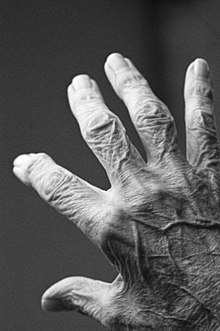Healthy eating habits/Eating for the Elderly
From the day we are born our body is constantly changing and this means it needs different fuels to perform at its best, especially as we get older. The needs of a teenage boy versus a pregnant woman are very different and this need for good nutrition does not stop when we reach our later years. In fact, as we are living longer lives it is even more important for older adults to be eating a healthy, balanced diet.

What happens as we get older?
[edit | edit source]A number of physical and environmental changes happen as people get older. These changes can affect people's' eating habits and potentially cause barriers to them eating well.

Physical and Environmental Changes
[edit | edit source]- Change in body composition: Decreased muscle mass means the body uses less fuel and requires less food
- Less saliva: More difficult to eat
- Dentures, missing teeth and swallowing problems: More difficult to eat
- Changes in appetite: Less hungry and thirsty
- Reduced senses: Taste and smell become dulled making food less appetising
- Changed sleep patterns: Skipping meals due to sleeping
- Decreased interest in cooking: Less willing to prepare meals
- Health issues: Need assistance to prepare or consume foods due to problems like arthritis
Nutritional Challenges
[edit | edit source]These changes may contribute to a poor nutrition status and increased risk of developing nutrition-related health problems. For example osteoporosis, falls and malnutrition become much more common in the elderly. This means that older adults need certain nutrients more than younger people to prevent these conditions from developing.
The Australian Dietary Guidelines
[edit | edit source]
The Australian Guide to Healthy Eating has accounted for and understands these changes that occur as we age and has developed a set of guidelines specifically for older people to use as a guide to meet their nutrition requirements. These guidelines aim to:
- Promote health and wellbeing
- Reduce the risk of diet-related conditions
- Reduce the risk of chronic diseases
The Australian Guide to Healthy Eating focuses on five main food groups. Vegetables, fruit, grains and cereals, meat and meat alternatives and dairy. It also includes 'sometimes' foods. Examples of foods from these food groups include:
- Vegetables: Fresh, frozen and tinned vegetables as well as beans and legumes
- Fruits: Fresh, frozen and tinned fruits as well as fruit juice and dried fruit occasionally (they are not recommended for everyday consumption because of their high sugar content)
- Grain and Cereals: Any foods made out of grains including pasta, rice, bread and cereal (Try to consume whole grain and high fibre options)
- Meat and Meat Alternatives: Red meat, poultry, fish, pork and eggs as well as non-animal sources such as nuts, tofu, beans and legumes
- 'Sometimes' foods: Cakes, pastries, processed meats, fried foods and sugar sweetened drinks
How much should I be eating?
[edit | edit source]People over the age of 70 should be aiming to eat:
| Food Group | No. of Serves Men | No. of Serves Women |
|---|---|---|
| Vegetables | 5 | 5 |
| Fruit | 2 | 2 |
| Grains/Cereals | 4.5 | 3 |
| Meat/Meat Alternatives | 2.5 | 2 |
| Dairy | 3.5 | 4 |
| 'Sometimes' foods | 2 | 2 |
What is a serve?
[edit | edit source]| Food Group | Serving Size | Why is this important? |
|---|---|---|
| Vegetables | A serve is ~75g: 1/2 cup cooked, 1/2 potato, 1 cup fresh salad leaves, 1/2 cup tinned, 1/2 cup beans/legumes | Provide a wide range of vitamins and minerals to help prevent deficiencies and keep you healthy |
| Fruit | A serve is ~150g: 1 medium piece (banana, apple, pear etc), 1 cup tinned (no added sugar), 2 small pieces (apricots, plums, kiwi etc) | Provide a wide range of vitamins and minerals to help prevent deficiencies and keep you healthy |
| Grains/Cereals | 1 slice of bread/medium role (40 g), 1/2 cup cooked pasta, rice or noodles, 2/3 cup breakfast cereal | Provides much of our daily energy allowing us to keep active – men need more because they are bigger |
| Meat/Meat Alternatives | 65 g cooked lean red meat, 80 g cooked lean poultry, 100 g cooked fish, 2 eggs, 1 cup beans, 30 g nuts | Keeps muscles strong and provides energy allowing us to do everyday activities – men need more because they are bigger |
| Dairy | 1 cup milk/milk alternative, 40 g cheese (2 slices), 3/4 cup yoghurt, 1/2 cup ricotta | Important for bone health – especially important for women post-menopause to protect against osteoporosis |
| 'Sometimes' foods | 2 scoops ice-cream, 60 g processed meat (~2 slices), 2-3 sweet biscuits, 2 tablespoons of jam/honey | Don't provide any essential nutrients and aren't needed as part of healthy, balanced diet |
More Information
[edit | edit source]For more information visit Nutrition Australia: Nutrition and Older Adults or the Australian Guide to Healthy Eating.
Or give them a call on:
- (03) 9348 0178 – Nutrition Australian
- (02) 6269 1080 – Eat for Healthy (Australian Guide to Healthy Eating)
References
[edit | edit source]National Health and Medical Research Council. (2013). Healthy Eating for Adults. Retrieved from https://www.eatforhealth.gov.au/sites/default/files/files/the_guidelines/n55g_adult_brochure.pdf.
- ↑ Brown, J. E., Krinke, U. B., Lechtenberg, E., Murtaugh, M. A., Sharbaugh, C., Splett, P. L., Stang, J., & Wooldridge, N. H. (2011). Nutrition Through the Lifecycle. Belmont, USA: Cengage Learning
- ↑ a b Australian Dietary Guidelines, Department of Health and Ageing, NHMRC, (2013). Healthy Eating for Adults. Retrieved from http://www.eatforhealth.gov.au/sites/default/files/files/the_guidelines/n55g_adult_brochure.pdf